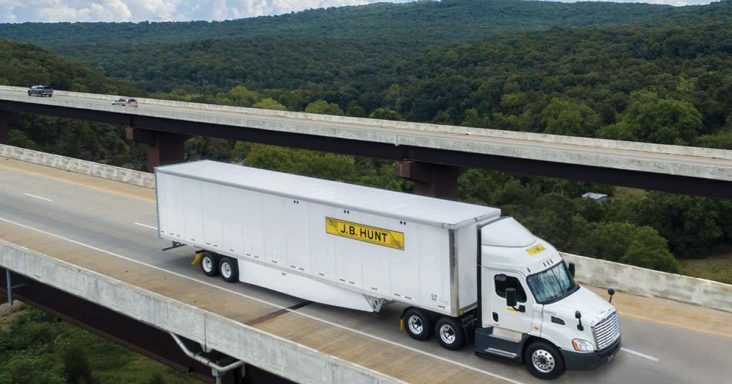Analysts say J.B. Hunt revenue, earnings to rise in second quarter
by July 12, 2021 2:01 pm 1,125 views

Lowell-based carrier J.B. Hunt Transport Services Inc. is expected to report double-digit growth in earnings and revenue as analysts look to multiple years of growth on the strong foundation that the company has built.
After the markets close Monday (July 19), J.B. Hunt is expected to post earnings per share of $1.55, up from $1.14 in the same period in 2020, based on a consensus of 21 analysts. Revenue is projected to rise by 26% to $2.7 billion, from $2.15 billion.
In a second-quarter preview, analysts Justin Long and Jack Atkins and associates George Sellers and Wade Schaller, all of Little Rock-based Stephens Inc., said “the company should see a significant ramp in earnings in (the second half of 2021) and 2022… We think a combination of double-digit intermodal pricing during this year’s bid season, potential for better-than-expected intermodal volume growth in 2022, a continuation of very strong dedicated sales activity and outperformance from the (Integrated Capacity Solutions) segment are likely to drive upside to Street estimates in the next 12-18 months.”
The analysts noted that a strong foundation has been built and expect multiple years of growth.
“We believe the stage is set for (J.B. Hunt) to see very strong growth in (the second half of 2021) and 2022 across various business segments,” analysts said. “We expect strong intermodal growth to be realized in the quarters ahead as pricing from this year’s bid season is implemented and volumes ramp with the delivery of more container capacity.”
More truck-to-rail conversions are expected if rail service improves and shippers focus more on reducing carbon emissions, the analysts added. In the dedicated segment, demand is expected to continue to be strong from increased outsourcing as a result of complicated supply chains and a tight driver market, leading to more contracts. Meanwhile, its technology platform, J.B. Hunt 360, is growing and becoming profitable, and the Google alliance is expected to start having a financial impact over the next one to two years. Overall, earnings per share are expected to rise by 40% in 2021 and 20% in 2022.
Also, valuation metrics could continue to rise based on “strong cyclical and secular growth drivers across various business segments and our sum-of-the-parts analysis valuing ICS separately from the rest of the business,” analysts said. “As a result, we are opportunistic buyers on the recent pullback in the stock.”
The analysts maintained the overweight, or buy, rating, and increased the 12-month target price by $5 to $195.
Shares of J.B. Hunt (NASDAQ: JBHT) were trading Monday afternoon at $164.77, down $1.01, or 0.6%. In the past 52 weeks, the stock has ranged between $183.80 and $119.22.
Following are expectations by segment and broader industry trends:
INTERMODAL
Capacity has been tight and pricing strong, but J.B. Hunt has more intermodal containers on the way. In the second quarter, demand was strong, but the carrier had yet to receive a significant portion of the 12,000 containers it had ordered. The new containers will add about 12% to its fleet of 99,043 containers, as of the end of March. Other segment impacts include rail service that’s slightly improved and customer delays that have led to containers being held longer than expected.
Analysts said pricing is trending slightly above expectations, and recent increases have been in the mid-teens. The pricing is expected to be a tailwind to earnings, and the additional containers should help also.
In 2022, intermodal volumes could rise, especially if rail service improves. The new containers and improved rail service could add between 20% and 25% capacity to the system. The analysts projected intermodal volumes to increase by 4.5% in 2021 and by 8% in 2022. If rail service improves, the volumes could rise by double digits.
DEDICATED
Over the past three quarters, dedicated truck sales have been 1,280 units, representing an annual sales rate of more than 1,700 units. J.B. Hunt had projected between 800 and 1,000 gross additions annually. In the second quarter, sales are projected to be strong, supporting growth levels higher than historical levels. Start-up costs could impact the segment, but the rise in top-line growth should more than offset the headwind over the next year.
BROKERAGE
ICS demand and volumes have been strong, but a mix of more contract business will affect gross margins. In the second quarter, the segment is expected to report strong growth. However, the addition of contract business could have a negative mix impact on margins with the contract business comprising a higher percentage of its total volumes compared to spot freight. The analysts expect gross margins to fall 1.3 percentage points in the second quarter, from the first. The five-year average decline is 1.1 percentage points between the two periods. Operating income is expected to be about $2 million.
BROADER TRENDS
Freight volumes rose by 26.8% in June, from the same month in 2020, but the volumes fell 4.2% from May, according to the Cass Freight Index. The decrease from May can be attributed to a decline in federal stimulus spending and tight supply – including driver and trailer shortages in the truckload and less-than-truckload segments and chassis shortages that have limited intermodal capacity.
Meanwhile, spending on freight increased at its fastest pace in June, up 56.4% from the same month in 2020. The previous record was a rise of 49.9% in May, from the same month last year. High growth rates are expected in the coming months as a result of rising shipment volumes and freight rates. The rates were up 23.4% in June, from the same month in 2020.
